 |
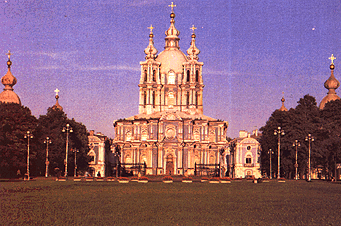 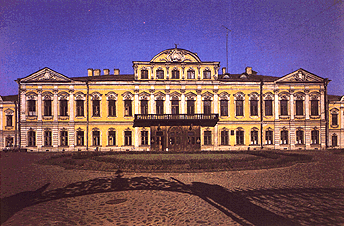 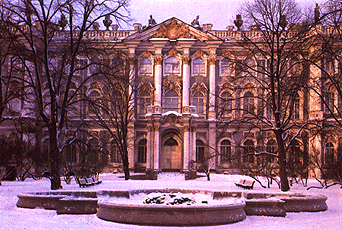
Baroque Architecture of St. Petersburg
The inimitable beauty of St. Peterburg architectural ensembles and squares was extolled by many poets. The city dates its
existence from May 16 (27, New Style), 1703, when the corner-stone of the Peter and Paul Fortress was laid. The city grew
rapidly in accordance with a well thought-out plan. Its unique architectural monuments were created by the genius of such
eminent Russian architects as Mikhail Zemtsov, Ivan Korobov and Piotr Yeropkin, and also by Western European masters - Domenico
Trezzini, Bartolommeo Francesco Rastrelli, Alexandre Jean-Baptiste Le Blond, and others. The early eighteeth-century architectural
ensembles were mainly constructed in the style known as the Petrine Baroque. The small buildings of the period are characterized
by laconic architectural forms and festive colourfulness. In St. Petersburg the Baroque style found its fullest expression
in Rastrelli's work. His Winter and Stroganov Palaces and the Smolny Convent are elegant and full of grandeur. The eighteenth-century
architecture greatly influenced the shaping of the city appearence. Some of the buildings of the time are real masterpieces
of world architecture.
 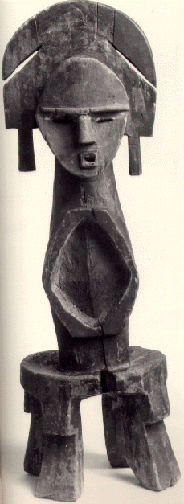
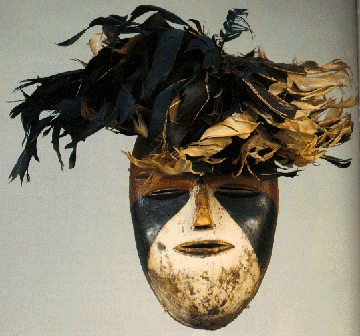
AFRICA
Africa has the longest human history of any continent. African
hominids date from at least 4 million years ago; agriculture, brought from SW Asia, appears to date from the 6th or 5th millennium
BC Africa's first great civilization began in Egypt in 3400 BC; other ancient centers were Kush and Aksum. Phoenicians established
Carthage in the 9th cent. BC and probably explored the northwestern coast as far as the Canary Islands by the 1st cent. BC
Romans conquered Carthage in 146 BC and controlled N Africa until the 4th cent. AD Arabs began their conquest in the 7th cent.
and, except in Ethiopia, Muslim traders extended the religion of Islam across N Africa and S across the Sahara into the great
medieval kingdoms of the W Sudan. The earliest of these kingdoms, which drew their wealth and power from the control of a
lucrative trans-Saharan trade in gold, salt, and slaves, was ancient Ghana, already thriving when first recorded by Arabs
in the 8th cent. In the 13th cent. Ghana was conquered and incorporated into the kingdom of ancient Mali, famous for its gold
and its wealthy capital of Timbuktu. In the late 15th cent. Mali was eclipsed by the Songhai empire and lost many provinces
but remained an autonomous kingdom.
|
 |
Section:
African Peoples
African peoples, who account for over 12% of the world's population, are distributed among 54 nations
and are further distinguishable in terms of linguistic (see African languages ) and cultural groups, which number around 1,000. The Sahara forms a great ethnic divide. North of it, mostly Arabs predominate
along the coast and Berbers (including the Tuareg) and Tibbu in the interior regions. Sub-Saharan Africa is occupied by a
diverse variety of peoples including, among others, the Amhara, Mossi , Fulani , Yoruba , Igbo , Kongo (see Kongo, kingdom of ), Zulu (see Zululand ), Akan , Oromo , Masai , and Hausa . Europeans are concentrated in areas with subtropical climates or tropical climates modified by altitude; in the south are
persons of Dutch and British descent, and in the northwest are persons of French, Italian, and Spanish descent. Lebanese make
up an important minority community throughout W Africa, as do Indians in many coastal towns of S and E Africa. There are also
significant Arab populations both in E Africa and more recently in W Africa. As a whole, Africa is sparsely populated; the
highest densities are found in Nigeria, the Ethiopian highlands, the Nile valley, and around the Great Lakes (which include
Victoria and Tanganyika). The principal cities of Africa are usually the national capitals and the major ports, and they usually
contain a disproportionately large percentage of the national populations; Cairo, Lagos (Nigeria), Kinshasa (Democratic Republic
of the Congo), Alexandria (Egypt), and Casablanca (Morocco) are the largest cities of Africa.
Economy
Most of Africa's population is rural, but, except for cash crops, such
as cacao and peanuts, agricultural production is low by world standards; Africa produces three quarters of the world's cocoa
beans and about one third of its peanuts. Rare and precious minerals (including much of the world's diamonds) are abundant
in the continent's ancient crystalline rocks, which are found mostly to the south and east of a line from the Gulf of Guinea
to the Sinai Peninsula; extensive oil, gas, and phosphate deposits occur in sedimentary rocks to the north and west of this
general line. Manufacturing is concentrated in the Republic of South Africa and in N Africa (especially Egypt and Algeria).
Despite Africa's enormous potential for hydroelectric power production, only a small percentage of it has been developed.
Africa's fairly regular coastline affords few natural harbors, and the shallowness of coastal waters makes it difficult for
large ships to approach the shore; deepwater ports, protected by breakwaters, have been built offshore to facilitate commerce
and trade. Major fishing grounds are found over the wider sections of the continental shelf as off NW, SW, and S Africa and
NW Madagascar.
 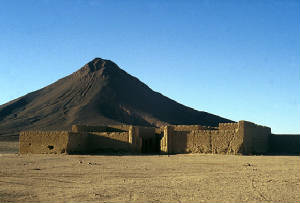  African art Related: Prehistoric Art
|
art created by
the peoples south of the Sahara. The predominant art forms are masks and figures, which were generally
used in religious ceremonies. The decorative arts, especially in textiles and in the ornamentation of everyday tools, were
a vital art in nearly all African cultures. The lack of archaeological excavations restricts knowledge of the antiquity of
African art. As the value of these works was inseparable from their ritual use, no effort was made to preserve them as aesthetic
accomplishments. Wood was one of the most frequently used materials—often embellished by clay, shells, beads, ivory,
metal, feathers, and shredded raffia. The discussion in this article is limited to the works of the peoples of W and central
Africa—the regions richest (because of the people's sedentary lifestyles) in indigenous art.
Section: Influence on Western Art
Related: Prehistoric Art
African art came to European notice c.1905, when
artists began to recognize the aesthetic value of African sculpture. Such artists as Vlaminck , Derain , Picasso , and Modigliani were influenced by African art forms. Interest in the arts of Africa
has flourished, and many modern Western artists have rediscovered the enduring qualities of African art. In the latter part
of the 20th cent., African art has come to be appreciated for its intrinsic aesthetic value as well as continuing to be a
source of inspiration for the work of Western artists.
African
literature 
Related: Miscellaneous World Literature
literary works of the African continent. African literature
consists of a body of work in different languages and various genres, ranging from oral literature to literature written in
colonial languages (French, Portuguese, and English). See also African languages ; South African literature .
Oral literature, including stories, dramas,
riddles, histories, myths, songs, proverbs, and other expressions, is frequently employed to educate and entertain children.
Oral histories, myths, and proverbs additionally serve to remind whole communities of their ancestors' heroic deeds, their
past, and the precedents for their customs and traditions. Essential to oral literature is a concern for presentation and
oratory. Folktale tellers use call-response techniques. A griot (praise singer) will accompany a narrative with music.
Some of the first African writings to gain attention in the West were the poignant slave narratives, such as The Interesting
Narrative of the Life and Adventures of Olaudah Equiano or Gustavus Vassa, the African (1789), which described vividly
the horrors of slavery and the slave trade. As Africans became literate in their own languages, they often reacted against
colonial repression in their writings. Others looked to their own past for subjects. Thomas Mofolo, for example, wrote Chaka
(tr. 1931), about the famous Zulu military leader, in Susuto.
Since the early 19th cent. writers
from western Africa have used newspapers to air their views. Several founded newspapers that served as vehicles for expressing
nascent nationalist feelings. French-speaking Africans in France, led by Léopold Senghor , were active in the négritude movement from the 1930s, along with Léon Damas and Aimé Césaire , French speakers from French Guiana and Martinique. Their poetry not
only denounced colonialism, it proudly asserted the validity of the cultures that the colonials had tried to crush.
After World War II, as Africans began demanding their independence, more African writers were published. Such writers as,
in western Africa, Wole Soyinka , Chinua Achebe , Ousmane Sembene , Kofi Awooner, Agostinho Neto , Tchicaya u tam'si, Camera Laye, Mongo Beti, Ben Okri, and Ferdinand
Oyono and, in eastern Africa, Ngugi wa Thiong'o , Okot p'Bitek , and Jacques Rabémananjara produced poetry, short stories, novels,
essays, and plays. All were writing in European languages, and often they shared the same themes: the clash between indigenous
and colonial cultures, condemnation of European subjugation, pride in the African past, and hope for the continent's independent
future.
In South Africa, the horrors of apartheid have, until the present, dominated the literature.
Es'kia Mphahlele , Nadine Gordimer , Bessie Head , Dennis Brutus , J. M. Coetzee, and Miriam Tlali all reflect in varying degrees in their writings the experience of living
in a racially segregated society.
Much of contemporary African literature reveals disillusionment
and dissent with current events. For example, V. Y. Mudimbe in Before the Birth of the Moon (1989) explores a doomed
love affair played out within a society riddled by deceit and corruption. In Kenya Ngugi wa Thiong'o was jailed shortly after
he produced a play, in Kikuyu, which was perceived as highly critical of the country's government. Apparently, what seemed
most offensive about the drama was the use of songs to emphasize its messages.
The weaving of music
into the Kenyan's play points out another characteristic of African literature. Many writers incorporate other arts into their
work and often weave oral conventions into their writing. p'Bitek structured Song of Iowino (1966) as an Acholi poem;
Achebe's characters pepper their speech with proverbs in Things Fall Apart (1958). Others, such as Senegalese novelist
Ousmane Sembene, have moved into films to take their message to people who cannot read.
Bibliography: See
R. Finnegan, Oral Literature in Africa (1970); R. Smith, ed., Exile and Tradition: Studies in African and Caribbean Literature
(1976); W. Soyinka, Myth, Literature and the African World (1976); A. Irele, The African Experience in Literature and Ideology
(1981); B. W. Andrzejewski et al., Literature in African Languages (1985); S. Gikandi, Reading the African Novel (1987). |
|
African music  Related: Music History Related: Music History
the music of the indigenous peoples of Africa. Sub-Saharan African music has as its distinguishing
feature a rhythmic complexity common to no other region. Polyrhythmic counterpoint, wherein two or more locally independent
attack patterns are superimposed, is realized by handclaps, xylophones, rattles, and a variety of tuned and nontuned drums.
The remarkable aspect of African polyrhythm is the discernible coherence of the resultant rhythmic pattern. Pitch polyphony
exists in the form of parallel intervals (generally thirds, fourths, and fifths), overlapping choral antiphony and solo-choral
response, and occasional simultaneous independent melodies. In addition to voice, many wind and string instruments perform
melodic functions. Common are bamboo flutes, ivory trumpets, and the one-string ground bow, which uses a hole in the ground
as a resonator. During colonial times, European instruments such as saxophones, trumpets, and guitars were adopted by many
African musicians; their sounds were integrated into the traditional patterns. Scale systems vary between regions but are
generally diatonic. Music is highly functional in ethnic life, accompanying birth, marriage, hunting, and even political activities.
Much music exists solely for entertainment, ranging from narrative songs to highly stylized musical theater. Similarities
with other cultures, particularly Indian and Middle Eastern, can be ascribed primarily to the Islamic invasion (7th-11th cent.).
See gospel music ; jazz ; spiritual .
Bibliography: See A. M. Jones, Studies in African Music (2 vol., 1959); R. Brandel, The Music
of Central Africa (1961); F. Warren, The Music of Africa (1970); F. Bebey, African Music (1972); W. Bender, Sweet Mother:
Modern African Music (1991). |
click here for the website on African Culture
QUESTIONS ABOUT AFRICA:
1. In what does the riches of African economy lie?
2. What are the common African art forms? Where are they used?
3. What are the forms of African oral literature?
4. What are the characteristics of African music? Where is music used?
5. Why is music important in African life?
6. What is the importance of Africa to archeology?
7. Why did Africa favor early human evolution?
8. Why is Nile Valley important to human civilization?
9. How did the slave trade come to Africa?
10. What is the effect of Colonialism to the African people?
11. What is the influence of Africa to the United States today?
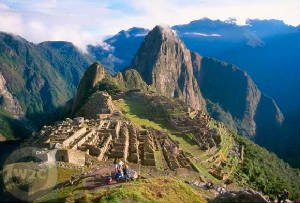 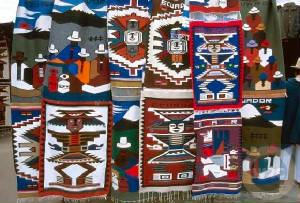 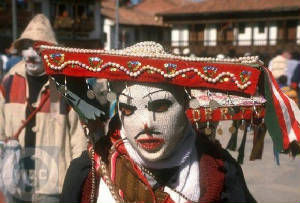 
SOUTH AMERICA
Economy
Beginning in the 17th cent., the exploitation of the continent's resources and the development of its industries were
the result of foreign investment and initiative, especially that of Spain, the United Kingdom, and the United States, but
since World War II the nations of South America have sought greater economic independence. An increasing number of South American
industrial centers have developed heavy industries to supplement the light industries on which they had previously concentrated.
An early obstacle to industrial growth in South America was the scarcity of coal. The continent
has therefore relied on its petroleum reserves, most notably in Venezuela and also in Argentina, Colombia, Chile, Peru, and
Ecuador, as a source of fuel. South Americans also have gradually developed their natural-gas reserves; hydroelectric plants
produce most of the continent's electricity. Iron-ore deposits are plentiful in the Guiana and Brazilian highlands, and copper
is abundant in the central Andes mountain region of Chile and Peru. Other important mineral resources include tin in Bolivia,
manganese and gold in Brazil, and bauxite in Guyana and Suriname.
Subsistence farming is widespread,
with about 30% of the people working about 15% of the land. Dense forests, steep slopes, and unfavorable climatic conditions,
along with crude agricultural methods, limit the amount of cultivable land. Commercial agriculture, especially of the plantation
type, fares better in terms of production because of the large scale and the opportunity to use modern, mechanized methods.
Among the agricultural exports are coffee, bananas, sugarcane, tobacco, and grains. Meat is also an important export. In the
interior, hunting and gathering of forest products are the chief economic activities of the indigenous peoples. Fishing is
also a central industry. In the more accessible areas, forest products are removed for export.
PEOPLE
Native peoples constitute a significant portion of the continent's Andean population, especially in Bolivia, Ecuador,
Peru, and Paraguay. Elsewhere in South America the population is generally mestizo, although Chile, Argentina, Uruguay, and
S Brazil have primarily European populations. There are sizable populations of African descent in NE Brazil, French Guiana,
Suriname, Guyana, Venezuela, and Colombia. Immigration since 1800 has brought European, Middle Eastern, and Asian (especially
Japanese) peoples to the continent, particularly to Argentina and Brazil.
With the exception of
Brazil and Ecuador, the national capitals have the largest populations and are the economic, cultural, and political centers
of the countries. Since World War II, the urban population has rapidly expanded. São Paulo, Brazil, whose population is nearly
10,000,000, is the largest city of South America and one of the fastest growing cities of its size in the world. Squatter
settlements have multiplied around urban areas as the poor and unskilled flock to the cities; widespread unemployment is common.
Outside the cities the population density of the continent is very low, with vast portions of the interior virtually uninhabited;
most of the people live within 200 mi (320 km) of the coast.
SHORT HISTORY
Penetration of South America started at the beginning of the 16th cent. Under the Treaty of Tordesillas, Portugal claimed
what is now Brazil, and Spanish claims were established throughout the rest of the continent with the exception of Guyana,
Suriname, and French Guiana. An Iberian culture and Roman Catholicism were early New World transplants—as were coffee,
sugarcane, and wheat. The subjugation of the indigenous civilizations was a ruthless accompaniment to settlement efforts,
particularly those of Spain. The Inca Empire, centered at Cuzco, Peru, was conquered (1531-35) by Francisco Pizarro; other native cultures quickly declined or
retreated in the face of conquest, conversion attempts, and subjugation. Spain and Portugal maintained their colonies in South
America until the first quarter of the 19th cent., when successful revolutions resulted in the creation of independent states.
The liberated countries generally struggled with political instability, with revolutions and military
dictatorships common and economic development hindered. Between 1820 and 1920, the continent received almost 6 million immigrants,
nearly all from Europe. Guyana gained independence from Great Britain in 1966 and Suriname from the Netherlands in 1975. French
Guiana is an overseas department of France. Beginning in the 1970s, road building and the clearing
of land led to the destruction of large areas of the Amazonian rain forests. International pressure and changes in government
policy, especially in Brazil, resulted in a decrease in the deforestation rate since the late 1980s, although burning and
illegal logging continue. Efforts to combat the illegal drug trade have been largely ineffective. Peru is one of the world's
largest growers of coca leaves, and Colombia is a center for the drug trade. Economic problems
and social inequality have led to considerable unrest and political instability. Many indigenous peoples, angered by centuries
of domination by a primarily European-descended upper class, have demanded a more equal distribution of land and power. Despite
the increasing industrialization of some countries, notably Brazil, Venezuela, and Argentina, and the widespread introduction
of free-market reforms in the 1990s, high inflation and huge foreign debt continued to be major problems for many South American
countries.
Bibliography:
See C. H. Haring, The Spanish Empire in America (1947, repr. 1963); K. E. Webb, Geography of Latin America (1972); G.
Philip, The Military in South American Politics (1985); J. D. Hill, ed., Rethinking History and Myth: Indigenous South American
Perspectives on the Past (1988); G. P. Atkins, ed., South America into the 1990s (1988); S. Bunker, Underdeveloping the Amazon
(1988); A. Daniels, Coups and Cocaine: Journeys in South America (1988); A. Cullison, The South Americans (1990).
QUESTIONS ABOUT SOUTH AMERICA:
1. What is the early obstacle to economic growth encountered by South American?
2. What are the mineral riches found in SA?
3. What are the factors that limit agricultural production?
4. In what countries can we find the native people of SA?
5. Why did the native culture decline in the 15th and 16th century?
6. What are the causes of unrest and political stability?
7. What problems did the newly liberated countries encounter in the 1900?
8. Why did the South American people revolt against the colonials countries of Spain and Portugal?
9. What are the problems encountered in large cities?
10. What is the influence of South American culture to the United States?

|









